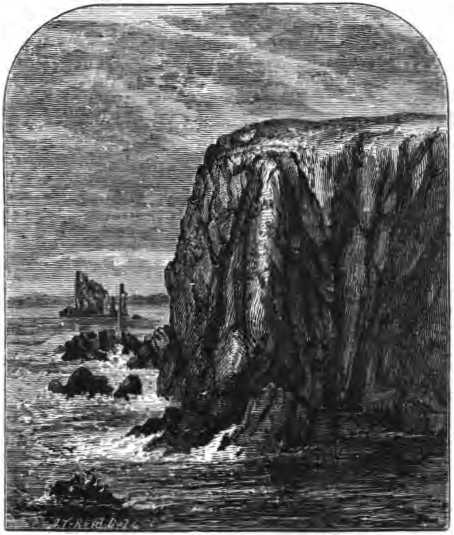|
HILLSWICK
THE large Voe of Urifirth
runs into the land for about three miles. Protected from the violence of
the Atlantic by the Ness of Hills wick, it is as safe a haven as could
be desired. On, and near to the low isthmus which connects the peninsula
just mentioned with the rest of the parish, Hillswick is built. For
centuries it appears to have been the most important place in
Northmavine, and this metropolitan character is still maintained. Here
stand the Parish Church and manse, and the mercantile establishment
where most of the business in the parish is transacted. An extensive
beach of well-rounded boulders, extending from the warehouses around
Hillswick House to the manse, is found very useful for completing the
drying of the fish brought from the different stations previous to their
exportation. Externally, the church presents a very neat appearance. The
front is Gothic, with a handsome belfry. The windows are small in
proportion to the size of the building, but this arrangement is
considered suitable to the climate of Shetland. Internally, it is fitted
up with an elegance that would do credit to any city church. St Magnus
Church—for that is its name —was erected in 1870 at a cost of XI700. The
heritors have behaved most generously in granting such a handsome
building. In doing so they must, no doubt, have remembered that the
present distinguished minister of Northmavine has, within the last few
years, erected a church at Ollaberry, and another at North Roe, free of
cost to the parish. Northmavine, whose population in 1871 amounted to
2572, is thus very adequately supplied with ordinances, both by the
Establishment and Dissenters.
A good parish school,
newly erected, stands at Uri-firth, at the head of the voe of that not
very euphonious name. Hamna Voe, a branch running north-eastwards, is
one of the safest harbours in Shetland. The headland, between those two
arms of the sea, consists of red granite, which is said to take on a
high polish, and to be peculiarly suitable for the construction of
piers, and other works requiring great durability. Shetland possesses
vast resources of this kind which have hitherto been utterly neglected.
Their development would be an enterprise of great importance.
Hillswick appears to have
been the abode of prehistoric man, for Mr Millen Coughtrey, a promising
student of medicine, when on a natural history expedition in that
district, in the autumn of 1870, came upon the remains of an ancient
kitchen midden, and examined its contents. “ Among these were four
long-handled bone-combs, seven other bone implements, including a broken
needle, four rude awls, a scraper, and a punch, various pieces of broken
pottery, the bones of domestic and other animals, some splintered, and
others showing teeth-marks of animals and marks of cutting produced by
man he also found the shells of the usual edible molluscs and a quantity
of fire-split pebbles. He considered it to be the tail-end of an
outlying kjokkenmodding of some broch, or of some solitary family
contemporary with the broch-dwellers. The principal portion of the heap
had evidently been washed away by the sea.”
There are many
temptations to linger in this very interesting district, but time speeds
on, and we must now, in the words of Claud Halcro, say—
“Farewell to Northmavine,
Grey Hillswick, farewell,—
To the calms of thy haven,
The storms on thy fell.”
On sailing southwards,
through the huge bay of St Magnus, whose great arms stretch from
Eshaness to Papa Stour, there is nothing in what remains of the
Northmavine coast worthy of special notice, except that it is singularly
stem and wild. Eagleshay, in the mouth of Magnussetter Voe, is rather a
pretty little ide, with a deep cliff dividing it into two unequal parts.
“This appearance has given birth to a monstrous tale. The two sons of a
deceased udaller, in sharing their father’s money between them, made use
of a cylindrical -wooden vessel, named a cog, which being unequally
divided within, by means of a transverse piece of wood, formed, when
turned on one end, double the measure that it was when resting on the
opposite margin. The younger son was blind, and the elder, in dealing
out the respective shares, clandestinely contrived to fill the greater
measure for himself, and the smaller one for his brother. "You have now
your share of the money," said the heir, whose eyes were perfect. ‘I
doubt it,’ said the blind one, ‘and may the Lord divide Eagleshay
to-morrow, as you have divided the money to-day/ The defrauded son had
his wish. After a horrible night of thunder and lightning, the island
was found in the morning split across by a deep rent into two parts, one
of which was just twice the size of the other.”

THE DRONGS. |

